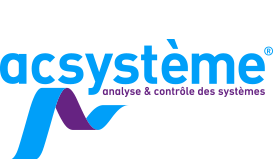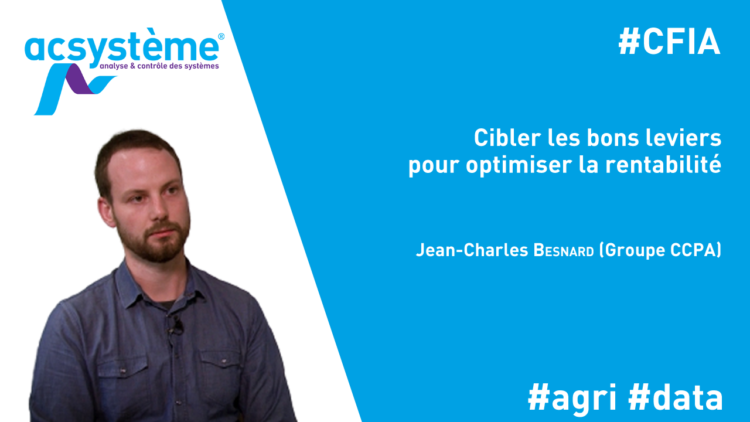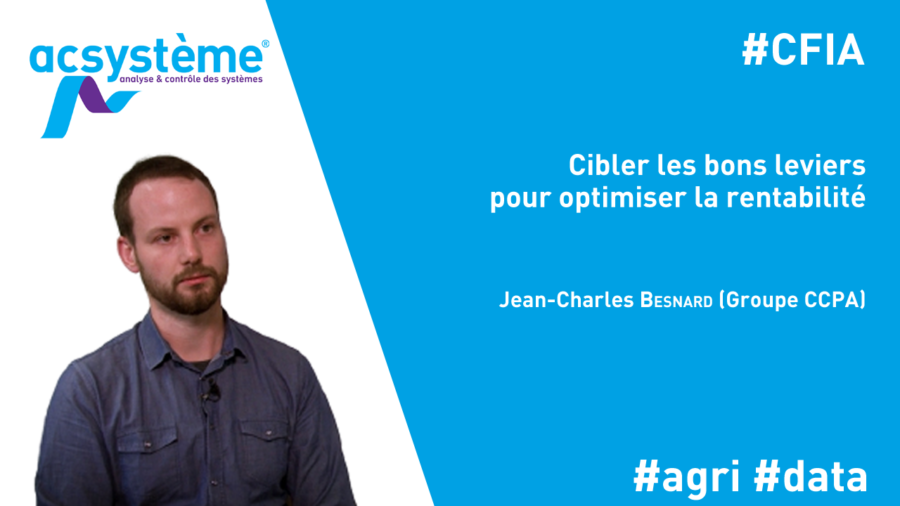– Hello Jean-Charles, please introduce yourself.
My name is Jean-Charles Besnard. I have a rather atypical background since I started by agricultural technical studies and continued by spending 5 years at engineering school at ESA in Angers. I joined CCPA 7 years ago as a product manager. My job is to advise feed manufacturers for farm animals in terms of nutrition depending upon their problems. For example, I will be able to advise a feed manufacturer who wishes to reduce the use of antibiotics on farm animals. I will advise him about nutrition so that he can achieve this goal, so that he can have feed that meets the expectations of the end customers, the farmers.
CCPA is a company known as a firm-service which sells products that are mixtures of vitamins and trace elements to meet the needs of animals, but most of my job is the nutrition service to feed manufacturers.
– How are pig farmers paid?
Today, farmers are paid according to the carcass quality of the pigs they rear. This carcass quality analysis method is fairly standardised in France. Carcass quality is defined by two main criteria:
- carcass fat thickness
- muscle thickness
These two criteria are measured by imaging. Through the individual data we collect, we can establish a link between each of these criteria and the weight of the animals.
For example, for a farmer, we know the link between his weight and his fat. For example, +1 kg equals +0.15 mm of fat, whilst for another farmer it may be +0.2 mm of fat. So, for the farmer where there is a greater relationship between weight and fat, we will be able to tell him that he may have to slaughter a little earlier to avoid having too much fat deposited in his animals.
That deals with carcass quality. The second point is weight homogeneity. Remuneration is also a function of the homogeneity of the weight between the different animals within a slaughtered batch. The objective for a farmer is to have the most homogeneous batch possible. This is something that we also analyse and that we can cost in terms of economic improvement through the tool that we have been able to design.
– What are CCPA’s actions to help farmers in this context?
CCPA is a company with more than 50 years’ experience in animal nutrition and the main businesses of which are the sale of technical products to feed manufacturers, which make it possible to respond to the problems of their farmers. A second facet of our business is consulting, both in terms of nutrition and also in terms of the data use for example. So, one of our jobs is to provide them with decision-making support tools for our end customers who are farmers but are direct customers of feed manufacturers.
There is a huge amount of data available at the farm level. The problem is that, today, these data are not exploited. So what we wanted to put in place is a tool to analyse all these data and from the analysis provide practical advice for farmers, so that they can improve their profitability at farm scale, using levers which can sometimes be very simple.
Depending on the individual data from the animals they bring to slaughter and the economic context, we manage to deduce an optimal weight at which the farmer should send these animals to slaughter in order to maximise his margin and his profitability, and at the same time meet consumer and sector expectations.
– What solution has Acsystème been able to provide?
We had started designing a tool, but in Excel. We were quickly confronted with all the limits of Excel in terms of both database size. We can have databases larger than 1 million rows, so that was problematic using Excel. There were also problems with calculation time. We had a previous version in which it could take more than half an hour to calculate for a farmer, so it was a bit complicated. Finally, we also had compatibility issues depending on our clients’ versions of Excel.
Since it is still a tool that was of interest to our customers and farmers given the economic challenges that it can represent, what we wanted to do was to industrialise the way of considering the tool.
Through our relationship with Acsystème, the objective was to solve these 3 problems. We had a relatively short deadline for this project since we already had customers who were users of the tool and who used it regularly for advice to their breeders. We had a deadline of 3 months to make a robust tool. Acsystème therefore supported us in the development of the tool.
We had many discussions about the structuring of the final tool we wanted so that it did not stray too far from the tool we had at the start. They developed the tool on Matlab, which made it possible to reduce calculation times, to have easy installation and to be able to generate a database with a very large amount of data.
– What is the advantage for a farmer of having a study report on these data?
Firstly, it enables you to see the evolution of its performance over time, whether it is from one week to another, from one month to another or from one year to another. Since these criteria are relatively fixed, they can be compared from one year to the next and see if it manages to improve its performance.
The second advantage is to be able to compare oneself with other farmers in the same group. Our customers are mainly cooperatives and the objective for a farmer can be to compare himself with other farmers in the same group. This will make it possible to highlight carcass quality criteria, for example, where it will be a little worse than the group reference, and therefore it can be a lever for action to improve this criterion.
The third area for improvement is to use this individual slaughter data coupled with feeding plan practices for these animals, and the overall economic context to make it possible to set an optimal weight at which the farmer must send his pigs to slaughter to maximise his margin.
So, the objective here is really to improve profitability at the farm level.
– What statistical method is used in this “Matlab” decision-making support tool?
What is interesting in statistics is not only the method but being able to convey the message to our contact. In this case, our final contact is the farmer. The farmer has no statistical skills, so the aim is to send a clear message through the tool that we have been able to design.
The statistical method we used was simple linear regressions between, for example, the weight of the farmer’s animals and the different carcass quality criteria specific to his farm. This enables us to set up models to evaluate what the optimal weight might be to maximise the margin per pig on his farm, by combining these linear relationships between weight and carcass quality with the overall economic context (price of pork and price of raw materials).
The idea will be to try to work like a dashboard, to try to see quite quickly what the evolution of the different carcass quality criteria is over time, to be able to position a farmer’s performance very easily compared with the group. We simply positioned a green lozenge, a red lozenge on a histogram to see what his position is, if he is more in the upper third, or in the lower third. These are small, simple visual indicators making it possible to find your position quickly. We put in small indicators: down arrow, up arrow for the different criteria to see if it was increasing or decreasing, and if it was positive or negative.
I have found that the advantage of a tool like Matlab is the possibility of having interactive graphics, in particular the possibility of being able to zoom on a very specific period. For example, if we have a farmer who had a period when his carcass quality had deteriorated, we can zoom in on a graph of this quality criterion as a function of time to see exactly which period it corresponds to, and which batches had this carcass quality problem.
– What is the feedback from users?
The best feedback is ultimately the feedback from farmers because the onus of the service and the decision-making tool is on them. There are a certain number of farmers with whom we carry out tests, as a firm service, and who regularly ask me whether I can give them a simulation with the decision-making tool to see what their optimal weight is in the current context of pork prices and raw material prices.
Good feedback is when end users come back to us for a simulation.


